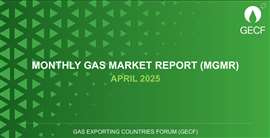Report: Global gas market steadies in early ‘25
April 28, 2025
GECF finds ‘cautious optimism’ in April report

Natural gas markets entered 2025 with cautious optimism as global consumption and production growth continued at a modest pace, supported by steady demand in North America and Asia, the Gas Exporting Countries Forum (GECF) reported in its April 2025 Monthly Gas Market Report.
Worldwide natural gas consumption is projected to rise by 2% in 2025, led by growth in North America and Asia. In March, gas demand in the European Union rose 5.2% year-over-year, reaching 32 billion cubic meters (Bcm), as colder weather and reduced renewable generation boosted gas-fired power demand. However, U.S. consumption fell 2.3% year-over-year to 77 Bcm, driven by lower residential, industrial, and power sector use.
On the supply side, global natural gas production is also forecast to grow by 2% this year, largely supported by output gains in the Middle East and North America. In March, U.S. production climbed 2.4% year-over-year to 92 Bcm. Meanwhile, European output continued its structural decline, falling 14% year-over-year in February, primarily due to lower production from Norway and the Netherlands.
Storage Trends Highlight Market Divergence
Storage dynamics painted a varied picture across major regions. In Europe, underground storage levels fell to 37 Bcm by the end of March — about 35% of capacity — after a colder-than-normal winter season. The U.S. also entered the injection season early due to mild March temperatures, but storage levels still fell to 49 Bcm (37% of capacity), well below last year’s levels.
Key Takeaways from the GECF Monthly Gas Market Report – April 2025
-
Global Gas Demand: Expected to grow 2% in 2025, driven by North America and Asia, despite U.S. consumption slipping 2.3% year-over-year in March.
-
Production Trends: U.S. natural gas output rose 2.4% year-over-year in March to 92 Bcm, while European production dropped sharply by 14% amid supply declines from Norway and the Netherlands.
-
Storage Levels: U.S. and European underground storage volumes fell below 2024 levels; early U.S. injections began in March, but Europe faces a challenging summer to refill storage to meet regulatory targets.
-
LNG Trade: Global LNG imports hit a record 37.8 Mt in March, up 8.4% year-over-year, with Europe remaining the top destination for U.S. LNG cargoes due to attractive TTF hub prices.
-
Price Outlook: Gas and LNG spot prices fell across all major hubs in March; economic risks and growing LNG supply are expected to exert further downward pressure into late 2025.
Asia mirrored this trend, with LNG storage in Japan and South Korea dropping to 8.3 Bcm in March, down from 10.2 Bcm a year earlier.
The GECF warned that Europe faces a challenging summer ahead to meet its regulatory gas storage targets. Roughly 60 Bcm will need to be injected by November 1 to reach mandated levels — a steeper task compared to the past two years.
Trade and Price Movements
Global LNG trade surged in March, with imports rising 8.4% year-over-year to 37.8 million tonnes — the strongest monthly increase since late 2022. Europe continued to attract U.S. LNG cargoes, helped by high TTF hub prices compared to Asian spot markets.
Nevertheless, gas price benchmarks declined sharply in March. European TTF and Northeast Asian (NEA) spot LNG prices each averaged $13/MMBtu, down 11% month-over-month. In the U.S., Henry Hub spot prices averaged $4.13/MMBtu, a 2% monthly decline.
Looking ahead, economic pressures from an escalating global trade war could further weigh on industrial gas demand. The GECF expects these macroeconomic risks, combined with rising LNG supply from new liquefaction projects, to keep downward pressure on gas prices into the second half of 2025.
Midstream Sector Outlook
For midstream operators, the early start to injection season and record LNG trade volumes provide growth opportunities — but tighter storage margins and global economic headwinds pose risks. Infrastructure flexibility, cross-basin trading strategies, and supply reliability will be critical for companies navigating the volatile 2025 market environment.
Additionally, with Europe and Asia expected to compete heavily for LNG cargoes this summer, U.S. LNG exports could remain elevated, offering continued throughput opportunities for pipeline operators and LNG terminal owners.
MAGAZINE
NEWSLETTER

CONNECT WITH THE TEAM








